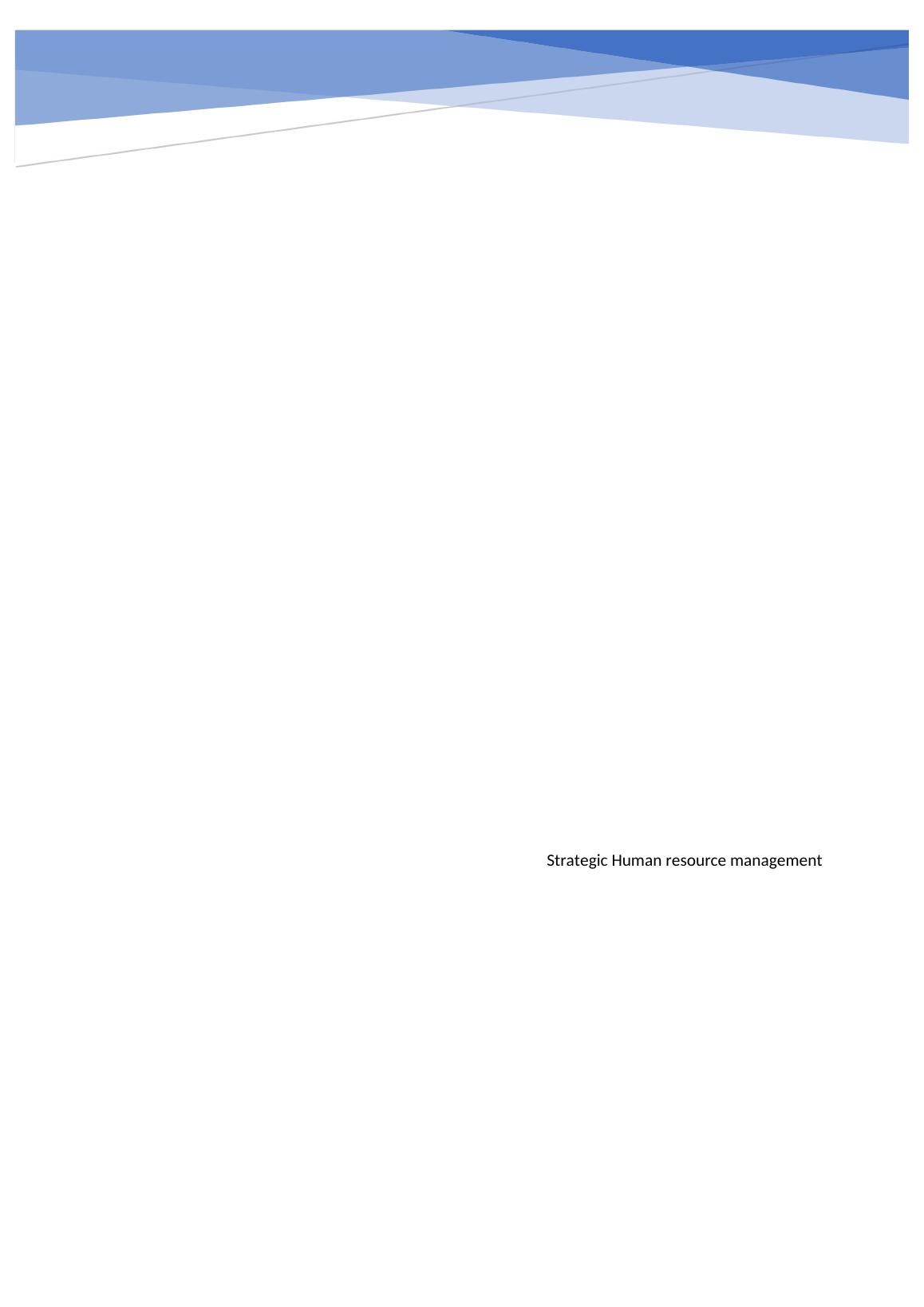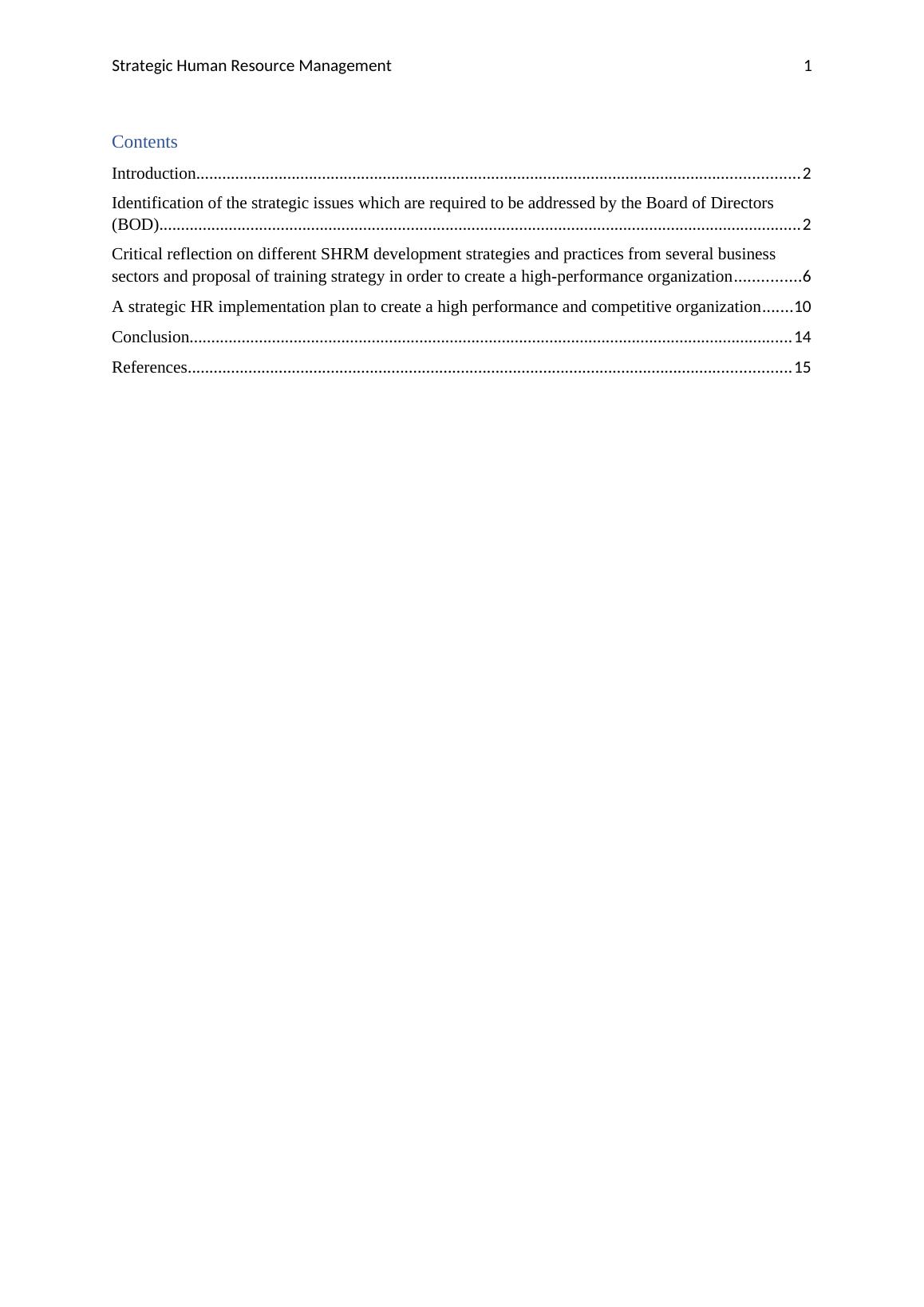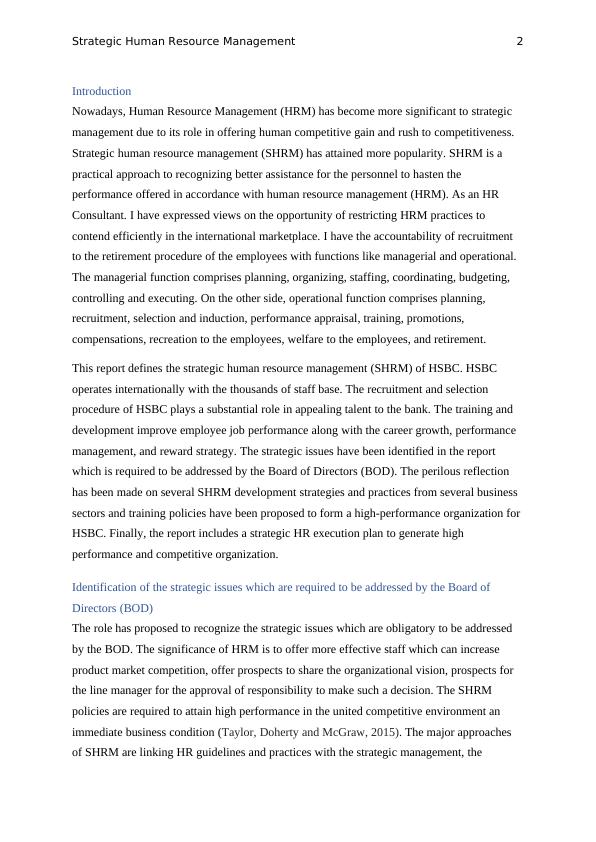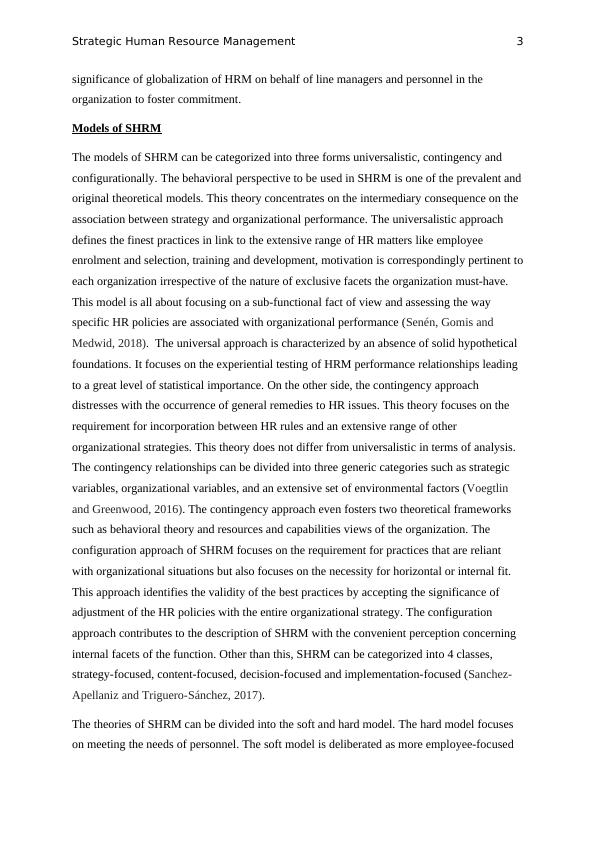Strategic Human Resource Management | Document
19 Pages7191 Words21 Views
Added on 2022-09-06
Strategic Human Resource Management | Document
Added on 2022-09-06
ShareRelated Documents
STRATEGIC HUMAN
RESOURCE
MANAGEMENT
RESOURCE
MANAGEMENT

Strategic Human Resource Management 1
Contents
Introduction............................................................................................................... 2
Identification of the strategic issues which are required to be addressed by the Board of Directors
(BOD)...................................................................................................................... 2
Critical reflection on different SHRM development strategies and practices from several business
sectors and proposal of training strategy in order to create a high-performance organization............6
A strategic HR implementation plan to create a high performance and competitive organization.....10
Conclusion.............................................................................................................. 14
References.............................................................................................................. 15
Contents
Introduction............................................................................................................... 2
Identification of the strategic issues which are required to be addressed by the Board of Directors
(BOD)...................................................................................................................... 2
Critical reflection on different SHRM development strategies and practices from several business
sectors and proposal of training strategy in order to create a high-performance organization............6
A strategic HR implementation plan to create a high performance and competitive organization.....10
Conclusion.............................................................................................................. 14
References.............................................................................................................. 15

Strategic Human Resource Management 2
Introduction
Nowadays, Human Resource Management (HRM) has become more significant to strategic
management due to its role in offering human competitive gain and rush to competitiveness.
Strategic human resource management (SHRM) has attained more popularity. SHRM is a
practical approach to recognizing better assistance for the personnel to hasten the
performance offered in accordance with human resource management (HRM). As an HR
Consultant. I have expressed views on the opportunity of restricting HRM practices to
contend efficiently in the international marketplace. I have the accountability of recruitment
to the retirement procedure of the employees with functions like managerial and operational.
The managerial function comprises planning, organizing, staffing, coordinating, budgeting,
controlling and executing. On the other side, operational function comprises planning,
recruitment, selection and induction, performance appraisal, training, promotions,
compensations, recreation to the employees, welfare to the employees, and retirement.
This report defines the strategic human resource management (SHRM) of HSBC. HSBC
operates internationally with the thousands of staff base. The recruitment and selection
procedure of HSBC plays a substantial role in appealing talent to the bank. The training and
development improve employee job performance along with the career growth, performance
management, and reward strategy. The strategic issues have been identified in the report
which is required to be addressed by the Board of Directors (BOD). The perilous reflection
has been made on several SHRM development strategies and practices from several business
sectors and training policies have been proposed to form a high-performance organization for
HSBC. Finally, the report includes a strategic HR execution plan to generate high
performance and competitive organization.
Identification of the strategic issues which are required to be addressed by the Board of
Directors (BOD)
The role has proposed to recognize the strategic issues which are obligatory to be addressed
by the BOD. The significance of HRM is to offer more effective staff which can increase
product market competition, offer prospects to share the organizational vision, prospects for
the line manager for the approval of responsibility to make such a decision. The SHRM
policies are required to attain high performance in the united competitive environment an
immediate business condition (Taylor, Doherty and McGraw, 2015). The major approaches
of SHRM are linking HR guidelines and practices with the strategic management, the
Introduction
Nowadays, Human Resource Management (HRM) has become more significant to strategic
management due to its role in offering human competitive gain and rush to competitiveness.
Strategic human resource management (SHRM) has attained more popularity. SHRM is a
practical approach to recognizing better assistance for the personnel to hasten the
performance offered in accordance with human resource management (HRM). As an HR
Consultant. I have expressed views on the opportunity of restricting HRM practices to
contend efficiently in the international marketplace. I have the accountability of recruitment
to the retirement procedure of the employees with functions like managerial and operational.
The managerial function comprises planning, organizing, staffing, coordinating, budgeting,
controlling and executing. On the other side, operational function comprises planning,
recruitment, selection and induction, performance appraisal, training, promotions,
compensations, recreation to the employees, welfare to the employees, and retirement.
This report defines the strategic human resource management (SHRM) of HSBC. HSBC
operates internationally with the thousands of staff base. The recruitment and selection
procedure of HSBC plays a substantial role in appealing talent to the bank. The training and
development improve employee job performance along with the career growth, performance
management, and reward strategy. The strategic issues have been identified in the report
which is required to be addressed by the Board of Directors (BOD). The perilous reflection
has been made on several SHRM development strategies and practices from several business
sectors and training policies have been proposed to form a high-performance organization for
HSBC. Finally, the report includes a strategic HR execution plan to generate high
performance and competitive organization.
Identification of the strategic issues which are required to be addressed by the Board of
Directors (BOD)
The role has proposed to recognize the strategic issues which are obligatory to be addressed
by the BOD. The significance of HRM is to offer more effective staff which can increase
product market competition, offer prospects to share the organizational vision, prospects for
the line manager for the approval of responsibility to make such a decision. The SHRM
policies are required to attain high performance in the united competitive environment an
immediate business condition (Taylor, Doherty and McGraw, 2015). The major approaches
of SHRM are linking HR guidelines and practices with the strategic management, the

Strategic Human Resource Management 3
significance of globalization of HRM on behalf of line managers and personnel in the
organization to foster commitment.
Models of SHRM
The models of SHRM can be categorized into three forms universalistic, contingency and
configurationally. The behavioral perspective to be used in SHRM is one of the prevalent and
original theoretical models. This theory concentrates on the intermediary consequence on the
association between strategy and organizational performance. The universalistic approach
defines the finest practices in link to the extensive range of HR matters like employee
enrolment and selection, training and development, motivation is correspondingly pertinent to
each organization irrespective of the nature of exclusive facets the organization must-have.
This model is all about focusing on a sub-functional fact of view and assessing the way
specific HR policies are associated with organizational performance (Senén, Gomis and
Medwid, 2018). The universal approach is characterized by an absence of solid hypothetical
foundations. It focuses on the experiential testing of HRM performance relationships leading
to a great level of statistical importance. On the other side, the contingency approach
distresses with the occurrence of general remedies to HR issues. This theory focuses on the
requirement for incorporation between HR rules and an extensive range of other
organizational strategies. This theory does not differ from universalistic in terms of analysis.
The contingency relationships can be divided into three generic categories such as strategic
variables, organizational variables, and an extensive set of environmental factors (Voegtlin
and Greenwood, 2016). The contingency approach even fosters two theoretical frameworks
such as behavioral theory and resources and capabilities views of the organization. The
configuration approach of SHRM focuses on the requirement for practices that are reliant
with organizational situations but also focuses on the necessity for horizontal or internal fit.
This approach identifies the validity of the best practices by accepting the significance of
adjustment of the HR policies with the entire organizational strategy. The configuration
approach contributes to the description of SHRM with the convenient perception concerning
internal facets of the function. Other than this, SHRM can be categorized into 4 classes,
strategy-focused, content-focused, decision-focused and implementation-focused (Sanchez-
Apellaniz and Triguero-Sánchez, 2017).
The theories of SHRM can be divided into the soft and hard model. The hard model focuses
on meeting the needs of personnel. The soft model is deliberated as more employee-focused
significance of globalization of HRM on behalf of line managers and personnel in the
organization to foster commitment.
Models of SHRM
The models of SHRM can be categorized into three forms universalistic, contingency and
configurationally. The behavioral perspective to be used in SHRM is one of the prevalent and
original theoretical models. This theory concentrates on the intermediary consequence on the
association between strategy and organizational performance. The universalistic approach
defines the finest practices in link to the extensive range of HR matters like employee
enrolment and selection, training and development, motivation is correspondingly pertinent to
each organization irrespective of the nature of exclusive facets the organization must-have.
This model is all about focusing on a sub-functional fact of view and assessing the way
specific HR policies are associated with organizational performance (Senén, Gomis and
Medwid, 2018). The universal approach is characterized by an absence of solid hypothetical
foundations. It focuses on the experiential testing of HRM performance relationships leading
to a great level of statistical importance. On the other side, the contingency approach
distresses with the occurrence of general remedies to HR issues. This theory focuses on the
requirement for incorporation between HR rules and an extensive range of other
organizational strategies. This theory does not differ from universalistic in terms of analysis.
The contingency relationships can be divided into three generic categories such as strategic
variables, organizational variables, and an extensive set of environmental factors (Voegtlin
and Greenwood, 2016). The contingency approach even fosters two theoretical frameworks
such as behavioral theory and resources and capabilities views of the organization. The
configuration approach of SHRM focuses on the requirement for practices that are reliant
with organizational situations but also focuses on the necessity for horizontal or internal fit.
This approach identifies the validity of the best practices by accepting the significance of
adjustment of the HR policies with the entire organizational strategy. The configuration
approach contributes to the description of SHRM with the convenient perception concerning
internal facets of the function. Other than this, SHRM can be categorized into 4 classes,
strategy-focused, content-focused, decision-focused and implementation-focused (Sanchez-
Apellaniz and Triguero-Sánchez, 2017).
The theories of SHRM can be divided into the soft and hard model. The hard model focuses
on meeting the needs of personnel. The soft model is deliberated as more employee-focused

End of preview
Want to access all the pages? Upload your documents or become a member.
Related Documents
Fundamentals of human resource management | Reportlg...
|18
|4654
|111
Strategic Human Resource Management for HSBC Grouplg...
|9
|2482
|67
HR Systems Analysis of Standard Chartered Report 2022lg...
|30
|7087
|27
SHRMhrm Practices in Hsbc Assignmentlg...
|12
|4315
|13
Managing Human Resources in the Hospitality Industrylg...
|11
|3657
|305
Importance of HRM in HSBC Banklg...
|13
|3892
|1
